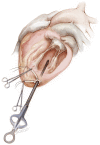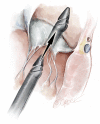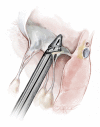Transapical NeoChord mitral valve repair
- PMID: 30598897
- PMCID: PMC6288219
- DOI: 10.21037/acs.2018.11.04
Transapical NeoChord mitral valve repair
Abstract
Transapical off-pump mitral valve repair (MVr) with NeoChord implantation has become widely applied in Europe for patients presenting with severe mitral regurgitation due to leaflet prolapse or flail. The procedure is performed under real-time 2D- and 3D-transesophageal echocardiography (TEE) for both implantation and neochordae tension adjustment allowing real-time monitoring of hemodynamic recovery. Preoperative anatomic and echocardiographic selection criteria, procedure refinement, as well as innovative ex-vivo surgical simulator training have been developed and strategically employed in the past few years, to generate a robust precision-based procedural framework with significantly enhanced operator use, patient safety and clinical outcomes. The procedure has evolved into a reproducibly successful and safe approach, which complements existing surgical treatment strategies available to eligible patients with chronic severe degenerative mitral regurgitation.
Keywords: Mitral regurgitation; NeoChord; mitral insufficiency; mitral valve flail; mitral valve prolapse; mitral valve repair (MVr).
Conflict of interest statement
Conflicts of Interest: A Colli, G Gerosa received travel grants from Neochord, Inc. D Adams is the Co-Principal Investigator of the Rechord Trial, which is supported by Neochord, Inc. The other authors have no conflicts of interest to declare.
Figures
















Similar articles
-
Transapical off-pump mitral valve repair. First experience with the NeoChord system in Poland (report of two cases).Kardiol Pol. 2017;75(1):7-12. doi: 10.5603/KP.a2016.0149. Epub 2016 Oct 7. Kardiol Pol. 2017. PMID: 27714712
-
Beating heart mitral valve repair with neochordae implantation: real-time monitoring of haemodynamic recovery.Eur J Cardiothorac Surg. 2017 Nov 1;52(5):991-992. doi: 10.1093/ejcts/ezx250. Eur J Cardiothorac Surg. 2017. PMID: 28977505
-
Measuring chordae tension during transapical neochordae implantation: Toward understanding objective consequences of mitral valve repair.J Thorac Cardiovasc Surg. 2019 Sep;158(3):746-755. doi: 10.1016/j.jtcvs.2018.10.029. Epub 2018 Oct 17. J Thorac Cardiovasc Surg. 2019. PMID: 30454983
-
Review of transapical off-pump mitral valve intervention with NeoChord implantation.Curr Opin Cardiol. 2021 Mar 1;36(2):130-140. doi: 10.1097/HCO.0000000000000825. Curr Opin Cardiol. 2021. PMID: 33394708 Review.
-
Microinvasive mitral valve repair with transapical mitral neochordae implantation.Front Cardiovasc Med. 2023 Jul 28;10:1166892. doi: 10.3389/fcvm.2023.1166892. eCollection 2023. Front Cardiovasc Med. 2023. PMID: 37576109 Free PMC article. Review.
Cited by
-
In vivo assessment of mitral valve leaflet remodelling following myocardial infarction.Sci Rep. 2022 Oct 26;12(1):18012. doi: 10.1038/s41598-022-22790-0. Sci Rep. 2022. PMID: 36289435 Free PMC article.
-
Continuous Microfiber Wire Mandrel-Less Biofabrication for Soft Tissue Engineering Applications.Adv Healthc Mater. 2022 Jul;11(13):e2102613. doi: 10.1002/adhm.202102613. Epub 2022 Apr 29. Adv Healthc Mater. 2022. PMID: 35394654 Free PMC article.
-
Minimally invasive and transcatheter approaches for mitral valve surgery.Indian J Thorac Cardiovasc Surg. 2020 Sep;36(5):492-501. doi: 10.1007/s12055-019-00901-3. Epub 2020 Mar 2. Indian J Thorac Cardiovasc Surg. 2020. PMID: 33061160 Free PMC article. Review.
-
Transcatheter mitral valve repair for primary mitral regurgitation.Rev Cardiovasc Med. 2022 Mar 26;23(4):116. doi: 10.31083/j.rcm2304116. eCollection 2022 Apr. Rev Cardiovasc Med. 2022. PMID: 39076234 Free PMC article. Review.
-
Transcatheter mitral valve repair: an overview of current and future devices.Open Heart. 2021 Apr;8(1):e001564. doi: 10.1136/openhrt-2020-001564. Open Heart. 2021. PMID: 33911022 Free PMC article. Review.
References
Publication types
LinkOut - more resources
Full Text Sources
Miscellaneous
